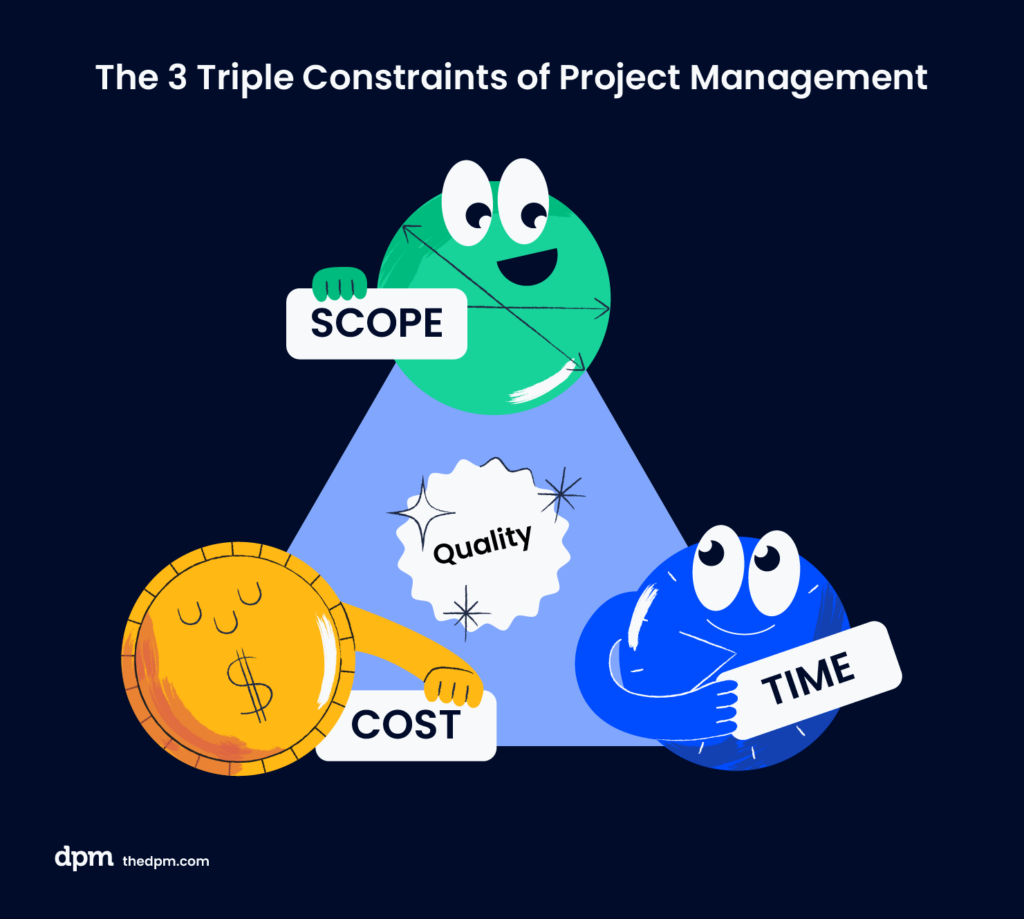The project management triangle is a way to visualize the 3 fundamental elements that drive projects: time, cost, and scope. Also known as the 'triple constraint,' it governs every single project you have or will undertake.
What Is The Project Management Triangle?
The project management triangle, also called the iron triangle or triple constraint, visually represents how time, cost, and scope in project management are interconnected.
When there is a change to one of these project constraints, something else has to give. The triangle can help you see what this something else is and give you a useful project management tool for explaining this to your stakeholders or clients, especially when they can’t understand why adding a landing page to their marketing campaign means you need more time or budget (or both!).
It shows that any changes in one aspect will affect the others. They are intricately intertwined, and any modification to one constraint will undoubtedly impact the others.
For example, if the project timeline is condensed, you’ll likely need additional resources, leading to increased costs. Similarly, expanding the project scope will likely increase the project duration and result in supplementary expenses.

Time
In project management, the time constraint encompasses both the project's schedule and the timeframe required for completion. Time factors to consider include:
- Overall Project Timeline: The comprehensive schedule outlining project milestones and completion dates.
- Number of Project Phases: The divisions or stages through which the project progresses from initiation to completion.
- Time Allotted for Planning and Strategy: The designated duration set aside for strategic planning and preparation.
- Hours Worked on Project: The cumulative amount of time invested by the team towards project execution.
- Internal Calendars and Goalposts: The specific timelines and milestones established internally to track progress and achievements.
Cost
While executing a project plan, the cost represents the financial resources required. As project managers, we are responsible for ensuring that our projects are completed on budget. Cost takes into account factors like:
- Financial Budget: The allocated monetary resources for the project's execution.
- Number of Team Members: The count and salary of individuals involved in executing the project.
- Equipment and Facilities: The necessary tools, technology, and physical spaces required for project implementation.
Scope
The scope constraint defines the specific objectives, deliverables, and requirements of a project. As a project manager, it is crucial to define, document, and agree with stakeholders on the scope of a project that aligns with the project's objectives.
Scope includes factors like:
- Project Complexity: The intricacy and sophistication of the project's components.
- Output Quality: The standard and excellence of the final deliverables.
- Number and Complexity of Features: The intricacy and quantity of functionalities within the project.
- Level of Detail: The depth and thoroughness with which components are addressed.
- Quantity of Finished Products: The total number of completed deliverables or products.
Why Is The Project Management Triangle Important?
The project management triangle is a fundamental concept that empowers project managers to make informed decisions and effectively manage expectations, ultimately driving successful project execution.
By providing a framework for decision-making and expectation management, the project management triangle helps project managers achieve desirable outcomes.
Let's delve deeper into the significance of the project management triangle.
1. It Establishes Realistic Project Goals
The project management triangle helps project managers set realistic goals. It takes into account the relationship between scope, time, and cost to assess project feasibility and establish achievable objectives. This ensures that the project is both well-defined and aligned with the organization's strategic goals.
For instance, when facing a project with both a limited budget and a tight deadline, the project manager can utilize the project management triangle to evaluate the feasible extent of work within these constraints.
This approach ensures that overpromising and under-delivering are avoided and that the project can be successfully completed in a high-quality way.
2. It Aids Effective Communication with Stakeholders
In project management, effective communication plays a crucial role. The project management triangle facilitates communication with stakeholders.
By understanding the trade-offs involved in a project, project managers can clearly convey the limitations and constraints to stakeholders right from the beginning, effectively managing their expectations.
When stakeholders possess a solid grasp of the project's scope, timeframe, and financial plan, they become empowered to offer valuable insights and make well-informed decisions. This openness enhances trust and encourages collaborative efforts, ultimately resulting in improved project outcomes.
3. It Helps Avoid Delays and Cost Overruns
The project management triangle helps project managers foresee and address potential delays and cost overruns. By examining the connections between scope, time, and cost, project managers can pinpoint potential risks and create backup plans to handle them effectively.
For example, if the scope of a project expands without a corresponding increase in time or budget, the project manager can proactively evaluate its impact on resources and make necessary adjustments to the plan.
This proactive approach reduces the risk of delays and cost overruns, keeping the project on schedule within its defined boundaries.
5 Tips for Managing Project Management Triangle
Project managers must skillfully balance the three constraints to effectively manage the project management triangle. Let's explore five strategies that can help project managers successfully navigate this challenging task.
1. Clearly Define Project Goals
To ensure alignment with stakeholders and avoid scope creep, it is essential to clearly define the project goals, objectives, and deliverables from the very beginning. This upfront clarification helps in maintaining focus and prevents misunderstandings down the line.
When we define project goals, it is crucial to involve all relevant stakeholders and gather their input. This collaborative approach ensures that we consider and align everyone's experiences.
By clearly articulating the purpose of the project, its desired outcomes, and measurable objectives, project managers can establish a shared understanding among project team members and create a sense of purpose and direction.
2. Analyze & Prioritize Activities
Project managers should analyze and prioritize activities to ensure that resources are allocated appropriately and efficiently towards accomplishing project objectives. The idea is to complete critical tasks first while evaluating which tasks can be delayed or eliminated.
Don't forget about your resource allocation! You'll need to consider the costs, personnel, materials, and any outside services that are required for a task and then analyze the availability and factor in existing or competing workloads to notice bottlenecks early on.
3. Keep an Eye on Project Progress
As a project manager, I regularly monitor and control the progress of my projects. This helps me identify any deviations from the schedule, cost, scope, or quality of the project.
Throughout the project, you should be continuously tracking the project's performance against the baseline plan and identifying any deviations or potential risks.
4. Regularly Share Project Updates With Stakeholders
Effective communication involves establishing transparent channels for sharing information, fostering active listening, and ensuring a constant flow of communication.
Regular updates on project progress, milestones, changes, and potential impacts are essential for keeping everyone informed. This allows stakeholders to provide timely feedback, voice concerns, and make collaborative decisions.
5. Keep Risk Under Control
Risk management isn’t so much a process as a lens to see your project through. In my own project management work, I proactively identify and handle potential project risks that could affect the triple constraints. Additionally, I develop contingency plans to address any possible issues and minimize their impact on the project.
As project managers, we can effectively minimize the risks of unexpected events disrupting our project's schedule, cost, or scope by actively identifying and managing them.
6. Use Project Management Software
The right project management tools are immensely helpful for keeping track of the many moving pieces that impact the project management triangle. Whatever the nature of your project, there’s a tool that can help to reduce the mental load of managing time, budget, and scope. Look for a tool that offers features compatible with your work environment, such as specialized software for Agile, Scrum, or waterfall project teams, or with functionality to generate visual aids like Gantt charts.
Keep Your Project On Track With The Project Management Triangle
Understanding the project management triangle is crucial for project managers. It allows them to effectively handle projects and achieve project success.
By recognizing the interconnection between time, cost, and scope, project managers can make informed decisions and keep projects on the right track.
If you found this content helpful, subscribe to The Digital Project Manager newsletter to get our latest articles directly delivered to your inbox.



